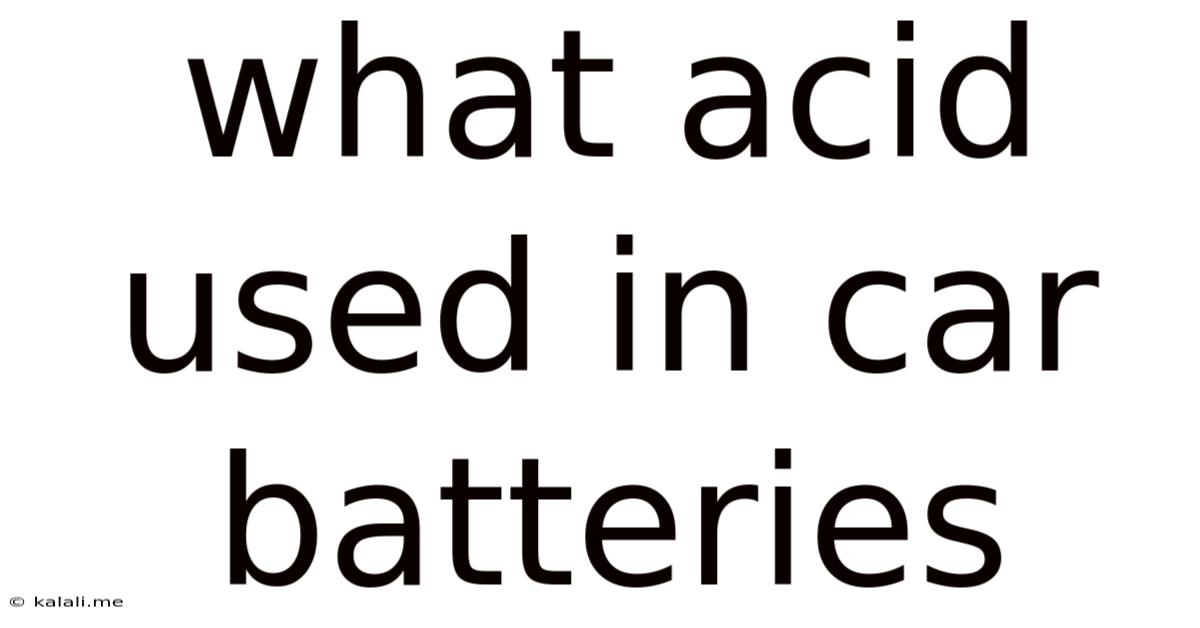What Acid Used In Car Batteries
Kalali
Jun 11, 2025 · 3 min read

Table of Contents
What Acid is Used in Car Batteries? Understanding Sulfuric Acid and its Role
Car batteries are essential for starting your vehicle, powering accessories, and ensuring a smooth driving experience. But what makes them tick? The answer lies in the potent chemical they contain: sulfuric acid. This article delves into the specifics of sulfuric acid's role in car batteries, exploring its properties and why it's the ideal choice for this critical automotive component.
Understanding Sulfuric Acid (H₂SO₄)
Sulfuric acid is a highly corrosive strong mineral acid. Its importance extends far beyond car batteries; it's used extensively in various industrial processes, from fertilizer production to petroleum refining. In the context of car batteries, its unique properties are what make it perfectly suited for the task. These properties include:
- High Conductivity: Sulfuric acid readily conducts electricity, a crucial requirement for a battery to effectively generate and store electrical energy. The movement of ions within the acid solution allows for the flow of electrons, powering your car's electrical system.
- Electrolytic Properties: It acts as an electrolyte, meaning it facilitates the chemical reactions that occur within the battery during charge and discharge cycles. These reactions involve the conversion between lead sulfate and lead, producing the electrical current.
- High Specific Gravity: The density of sulfuric acid is significantly higher than water, allowing for a compact energy storage solution. This high density contributes to the overall power output of the battery.
- Readily Available & Relatively Inexpensive: Sulfuric acid is relatively inexpensive and widely available, making it a cost-effective choice for mass production of car batteries.
How Sulfuric Acid Works in a Car Battery
A car battery, more accurately known as a lead-acid battery, utilizes sulfuric acid in an electrochemical reaction. The battery consists of lead plates immersed in a sulfuric acid solution. When the battery discharges (supplies power), the following happens:
- Lead (Pb) on the negative plate reacts with sulfate ions (SO₄²⁻) from the sulfuric acid, forming lead sulfate (PbSO₄).
- Lead dioxide (PbO₂) on the positive plate also reacts with sulfate ions and hydrogen ions (H⁺) from the sulfuric acid, forming lead sulfate (PbSO₄) and water (H₂O).
This process generates a flow of electrons, creating the electrical current. During charging, the process reverses, converting lead sulfate back to lead and lead dioxide, and replenishing the sulfuric acid concentration.
Safety Precautions with Sulfuric Acid
It's crucial to remember that sulfuric acid is a dangerous chemical. Direct contact can cause severe burns to skin and eyes. Always handle car batteries with care and follow safety guidelines:
- Wear protective gear: Gloves and eye protection are essential when working with car batteries.
- Ventilate the area: Sulfuric acid fumes can be harmful.
- Avoid spilling: Clean up any spills immediately and carefully.
- Proper disposal: Dispose of used car batteries responsibly at designated recycling centers.
Conclusion
Sulfuric acid plays a vital role in the functionality of car batteries. Its unique electrochemical properties make it the ideal electrolyte for generating and storing electrical energy. Understanding the properties and dangers associated with sulfuric acid is essential for safe handling and responsible battery maintenance. Remember to always prioritize safety when working with car batteries.
Latest Posts
Latest Posts
-
How Many 1 3 Cups Equal A Cup
Jul 01, 2025
-
How Many Hours Are In Two Years
Jul 01, 2025
-
Did You Hear About The Antelope Who Was Getting Dressed
Jul 01, 2025
-
How Many Units Are In 1 Ml
Jul 01, 2025
-
Write An Equation For These Two Complementary Angles
Jul 01, 2025
Related Post
Thank you for visiting our website which covers about What Acid Used In Car Batteries . We hope the information provided has been useful to you. Feel free to contact us if you have any questions or need further assistance. See you next time and don't miss to bookmark.